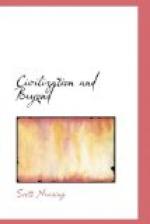(1) means of communication, record-keeping, transportation and trade. This would include a spoken language, a method of enumeration, writing in pictographs or symbols; an alphabet, a written language, inscribed on stone, bone, wood, parchment, paper; means of preserving the records of successive generations; paths, roads, bridges; a system for educating successive generations; meeting places and trading points; means for barter or exchange;
(2) an interdependent urban-oriented economy based on division of labor and specialization; on private property in the essential means of production and in consumer goods and services; on a competitive survival struggle for wealth, prestige and power between individuals and social groups; and on the exploitation of man, society and nature for the material benefit of the privileged few who occupy the summit of the social pyramid;
(3) a unified, centralized political
apparatus or bureaucracy
that attempts to plan, direct and
administer the political,
economic, ideological and sociological
structure;
(4) a self-selected and self-perpetuating
oligarchy that owns
the wealth, holds the power and
pulls the strings;
(5) an adequate labor force for
farming, transport, industry,
mining;
(6) large middle-class elements:
professionals, technicians,
craftsmen, tradesmen, lesser bureaucrats,
and a semi-parasitic
fringe of camp-followers;
(7) a highly professional, well-trained,
amply-financed apparatus
for defense and offense;
(8) a complex of institutions and
social practices which will
indoctrinate, persuade and when
necessary limit deviation
and maintain social conformity;
(9) agreed religious practices and other cultural features.
This description of civilization covers the essential features of western civilization and the sequence of predecessor civilizations for which adequate records exist.
Successive civilizations have introduced new culture traits and abandoned old ones as the pageant of history moved from one stage to the next, or advanced and retreated through cycles. Using this description as a working formula, it is possible to understand the development followed in the past by western civilization, to estimate its current status and to indicate its probable outcome.
Long-established thought-habits cry aloud in protest against such a description of civilization. Until quite recently the word “civilization” has been used in academic circles to symbolize a social idea or ideal. Professor of History Anson D. Morse of Amherst College presents such a view in his Civilization and the World War (Boston: Ginn 1919). For him, civilization is “the sum of things in which the heritage of the child of the twentieth century is better than that of the child of the Stone Age. As a process it is the perfection of man and mankind. As an end, it is the realization of the highest ideal which men are capable of forming.... The goal of civilization ... is human society so organized in all of its constituent groups that each shall yield the best possible service to each one and thereby to mankind as a whole, (producing) the perfect organization of humanity.” (page 3).




